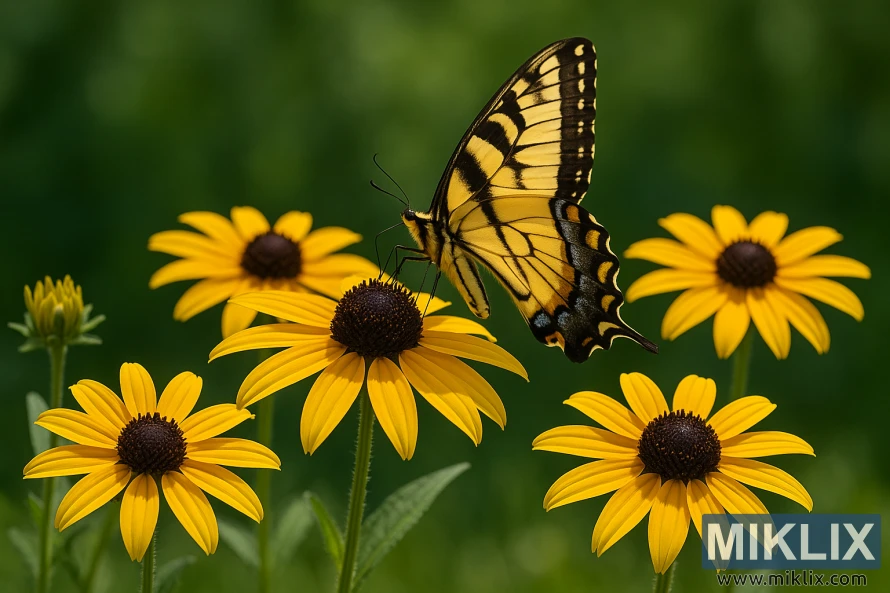Image: Eastern Tiger Swallowtail on a Black-Eyed Susan in Summer Sunlight
Published: October 27, 2025 at 9:10:27 PM UTC
A detailed summer image showing an Eastern Tiger Swallowtail butterfly feeding on a Black-Eyed Susan, highlighting the pollinator value of native wildflowers.
The image captures a radiant summer moment in stunning detail: an Eastern Tiger Swallowtail butterfly delicately perched atop a Black-Eyed Susan (Rudbeckia hirta) flower, illustrating the intricate relationship between native plants and their pollinators. The composition, in landscape orientation, is filled with warmth and vitality. The butterfly’s wings are spread in full display, showcasing their striking pattern — vivid yellow panels bordered and veined in black, with splashes of blue and orange near the lower edges. The insect’s fine, velvety body and gently curved antennae reveal remarkable textural precision. Its legs grasp the dark, conical center of the daisy-like flower, where it is actively feeding, gathering nectar and pollen in an act of natural synergy.
Surrounding the central flower are several other Black-Eyed Susans, each radiant with golden-yellow petals that form perfect circles around chocolate-brown domed centers. The petals, slightly curved and sunlit, exude a gentle glow. A few flower buds are visible as well, their tightly coiled petals promising future blooms. The lush green foliage below provides a rich, living base for the composition, while the softly blurred green background evokes a meadow or garden setting. The out-of-focus backdrop enhances depth, drawing full attention to the butterfly and flowers in the foreground.
The lighting is bright and natural, consistent with midday summer sunshine. The soft yet vivid illumination accentuates every hue: the brilliant yellows of the petals, the deep earthy tones of the flower centers, the sharp contrast of the butterfly’s wings, and the subtle sheen of its scales. The interplay of light and shadow across the butterfly’s body emphasizes its delicate anatomy — a living work of art that feels both fragile and dynamic.
The photograph captures not only a visually arresting scene but also a powerful ecological message. Black-Eyed Susans, native to North America, are beloved by pollinators — butterflies, bees, and other beneficial insects — providing nectar and habitat critical to the health of ecosystems. Here, the butterfly represents a symbol of renewal and natural harmony, thriving in a setting that celebrates biodiversity and sustainability. The connection between flora and fauna is palpable; one can almost imagine the faint hum of summer life — the movement of wings, the scent of warm petals, the hum of bees nearby.
Overall, this image radiates serenity, beauty, and purpose. Its composition is balanced and immersive, with strong visual contrast and warm tones that invite the viewer into the intimate world of a pollinator at work. The moment feels timeless — a perfect example of nature’s intricate design, where color, form, and function converge seamlessly. It’s not only a testament to the beauty of summer gardens but also a celebration of the essential role native plants play in sustaining wildlife and the environment.
The image is related to: A Guide to the Most Beautiful Varieties of Black-Eyed Susan to Grow in Your Garden

